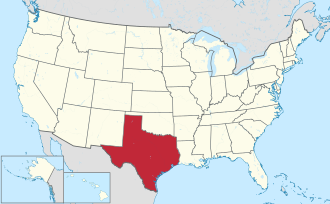History
A Dawson County was founded in 1856 from Kinney County, Maverick County, and Uvalde County, but was divided in 1866 between Kinney and Uvalde Counties. The current Dawson County was founded in 1876.
In 1943, the discovery well for the Spraberry Trend, the third-largest oil field in the United States by remaining reserves, [6] was drilled in Dawson County on land owned by farmer Abner Spraberry, for whom the geological formation and associated field were named. While most of the oil fields are in the counties to the south, a small portion of the Spraberry Trend is in Dawson County. Production on the field did not begin until 1949, and by 1951, an oil boom was underway in the area, with Midland at its center. [7]
Like all Texas counties as stipulated in the Texas Constitution of 1876, Dawson County has four commissioners chosen by single-member district and a countywide-elected county judge, the chief administrator of the county.
Demographics
Historical population| Census | Pop. | Note | %± |
|---|
| 1880 | 24 | | — |
|---|
| 1890 | 29 | | 20.8% |
|---|
| 1900 | 37 | | 27.6% |
|---|
| 1910 | 2,320 | | 6,170.3% |
|---|
| 1920 | 4,309 | | 85.7% |
|---|
| 1930 | 13,573 | | 215.0% |
|---|
| 1940 | 15,367 | | 13.2% |
|---|
| 1950 | 19,113 | | 24.4% |
|---|
| 1960 | 19,185 | | 0.4% |
|---|
| 1970 | 16,604 | | −13.5% |
|---|
| 1980 | 16,184 | | −2.5% |
|---|
| 1990 | 14,349 | | −11.3% |
|---|
| 2000 | 14,985 | | 4.4% |
|---|
| 2010 | 13,833 | | −7.7% |
|---|
| 2020 | 12,456 | | −10.0% |
|---|
| 2024 (est.) | 11,758 | [9] | −5.6% |
|---|
|
Dawson County, Texas – Racial and ethnic composition
Note: the US Census treats Hispanic/Latino as an ethnic category. This table excludes Latinos from the racial categories and assigns them to a separate category. Hispanics/Latinos may be of any race.| Race / Ethnicity (NH = Non-Hispanic) | Pop 2000 [14] | Pop 2010 [12] | Pop 2020 [13] | % 2000 | % 2010 | % 2020 |
|---|
| White alone (NH) | 6,439 | 5,402 | 4,590 | 42.37% | 39.05% | 36.85% |
| Black or African American alone (NH) | 1,285 | 860 | 847 | 8.58% | 6.22% | 6.80% |
| Native American or Alaska Native alone (NH) | 23 | 28 | 23 | 0.15% | 0.20% | 0.18% |
| Asian alone (NH) | 32 | 46 | 56 | 0.21% | 0.33% | 0.45% |
| Pacific Islander alone (NH) | 0 | 2 | 4 | 0.00% | 0.01% | 0.03% |
| Other race alone (NH) | 10 | 13 | 17 | 0.07% | 0.09% | 0.14% |
| Multiracial (NH) | 64 | 95 | 152 | 0.43% | 0.69% | 1.22% |
| Hispanic or Latino (any race) | 7,222 | 7,387 | 6,767 | 48.19% | 53.40% | 54.33% |
| Total | 14,985 | 13,833 | 12,456 | 100.00% | 100.00% | 100.00% |
As of the 2000 census, [15] 14,985 people, 4,726 households, and 3,501 families resided in the county. The population density was 17 people per square mile (6.6 people/km2). There were 5,500 housing units at an average density of 6 units per square mile (2.3/km2). The racial makeup of the county was 72.47% White, 8.66% Black or African American, 0.30% Native American, 0.25% Asian, 16.56% from other races, and 1.77% from two or more races. About 48.19% of the population were Hispanic or Latino of any race.
Of the 4,726 households, 35.1% had children under 18 living with them, 59.4% were married couples] living together, 11.0% had a female householder with no husband present, and 25.9% were not families. About 23.9% of all households were made up of individuals, and 13.3% had someone living alone who was 65 or older. The average household size was 2.69 and the average family size was 3.20. In the county, the population was distributed as 25.6% under 18, 8.9% from 18 to 24, 30.7% from 25 to 44, 20.5% from 45 to 64, and 14.3% who were 65 or older. The median age was 36 years. For every 100 females, there were 124.30 males. For every 100 females age 18 and over, there were 129.90 males.
The median income for a household in the county was $28,211, and for a family was $32,745. Males had a median income of $27,259 versus $16,739 for females. The per capita income for the county was $15,011. About 16.40% of families and 19.70% of the population were below the poverty line, including 29.20% of those under age 18 and 12.80% of those age 65 or over.
This page is based on this
Wikipedia article Text is available under the
CC BY-SA 4.0 license; additional terms may apply.
Images, videos and audio are available under their respective licenses.




